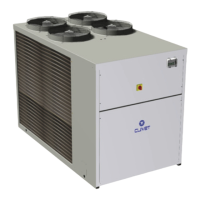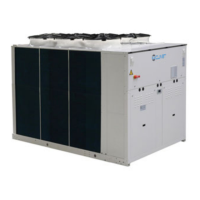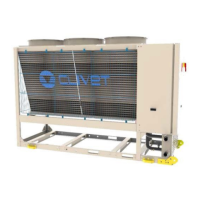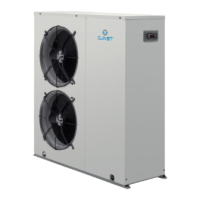Do you have a question about the CLIVET WSAN-XEE 302 and is the answer not in the manual?
Explains the serial number's role in unique identification, tracing features, and ordering spare parts.
Describes the cooling cycle in summer and the heating cycle in winter for the heat pump.
Covers intended use, safety precautions, data updates, and certifications.
Identifies danger zones around the unit and risks associated with handling and installation.
Details general risks like burning, contact with hot parts, and electrical system hazards.
Key factors to consider for installing the unit, including technical spaces and connections.
Specifies required clearances and criteria for selecting the unit's installation site.
Details on system emptying, expansion tanks, filters, unfreezable liquids, and antifreeze heaters.
Safety and compliance requirements for electrical connections by qualified personnel.
Essential checks for refrigerant, water, and electrical systems before initial start-up.
Modifies set points dynamically to optimize energy efficiency and adapt to external conditions.
Manages summer, winter, and secondary ECO set points for cooling and heating operations.
Guidelines for identifying, resetting, and understanding the causes of alarms and pre-alarms.
Lists all alarms, their descriptions, and whether they require manual or automatic reset.
Identifies causes and checks for high and low pressure alarms during cooling operation.
Troubleshooting steps for faulty probes and pressure transducers, including checks and replacement.
Diagnosing high and low pressure alarms during heating operation for various components.
Explains the serial number's role in unique identification, tracing features, and ordering spare parts.
Describes the cooling cycle in summer and the heating cycle in winter for the heat pump.
Covers intended use, safety precautions, data updates, and certifications.
Identifies danger zones around the unit and risks associated with handling and installation.
Details general risks like burning, contact with hot parts, and electrical system hazards.
Key factors to consider for installing the unit, including technical spaces and connections.
Specifies required clearances and criteria for selecting the unit's installation site.
Details on system emptying, expansion tanks, filters, unfreezable liquids, and antifreeze heaters.
Safety and compliance requirements for electrical connections by qualified personnel.
Essential checks for refrigerant, water, and electrical systems before initial start-up.
Modifies set points dynamically to optimize energy efficiency and adapt to external conditions.
Manages summer, winter, and secondary ECO set points for cooling and heating operations.
Guidelines for identifying, resetting, and understanding the causes of alarms and pre-alarms.
Lists all alarms, their descriptions, and whether they require manual or automatic reset.
Identifies causes and checks for high and low pressure alarms during cooling operation.
Troubleshooting steps for faulty probes and pressure transducers, including checks and replacement.
Diagnosing high and low pressure alarms during heating operation for various components.











